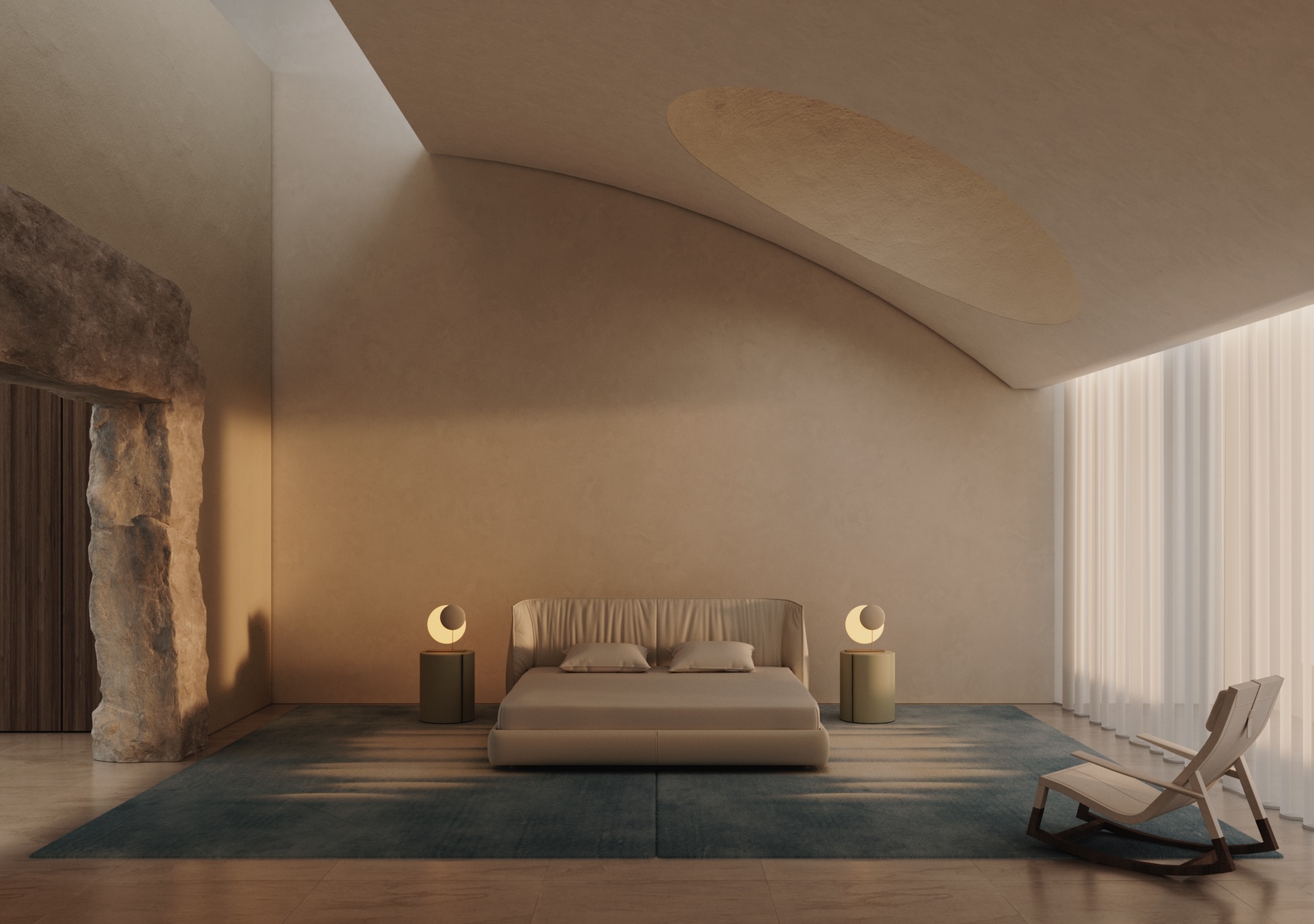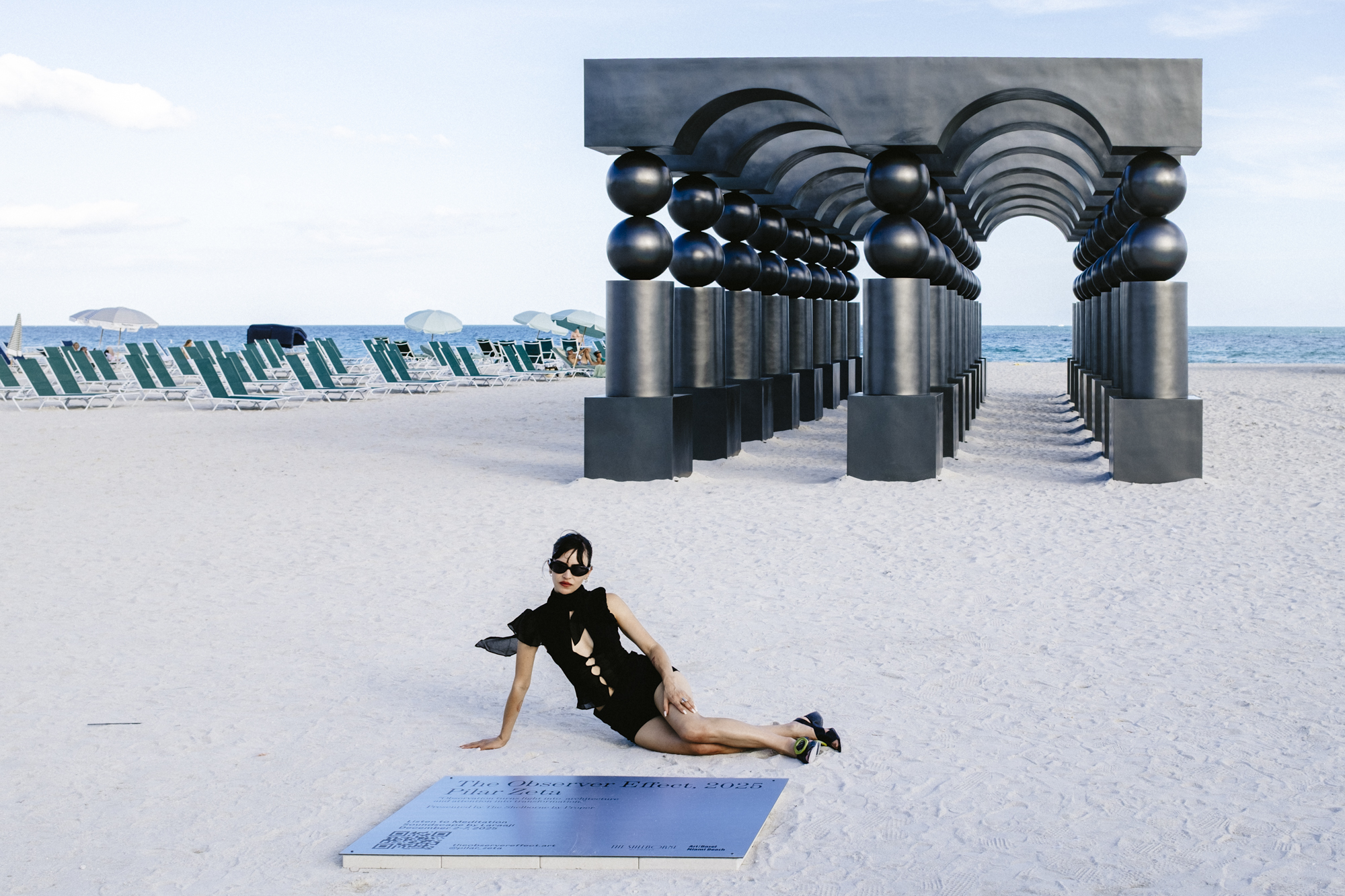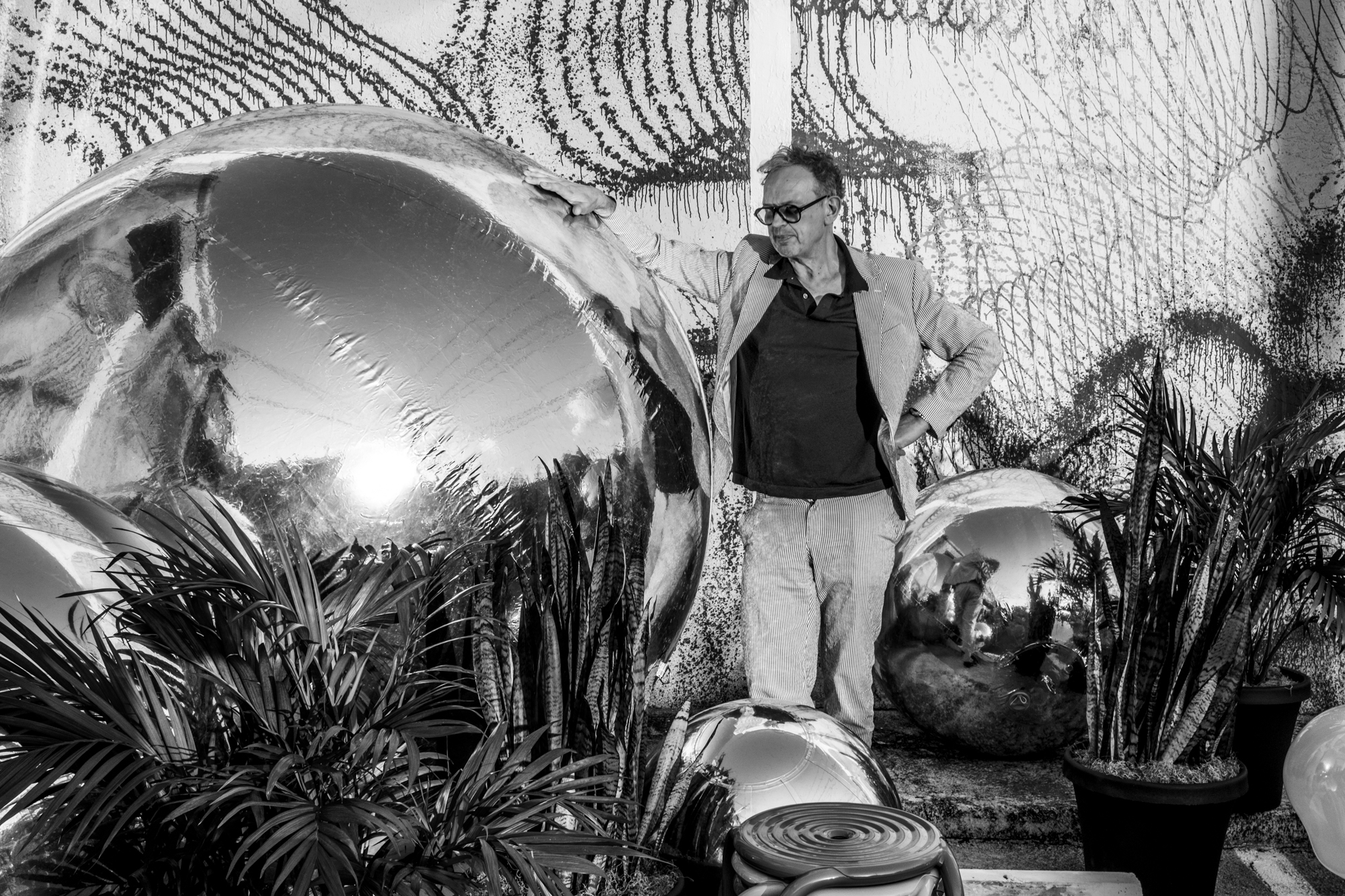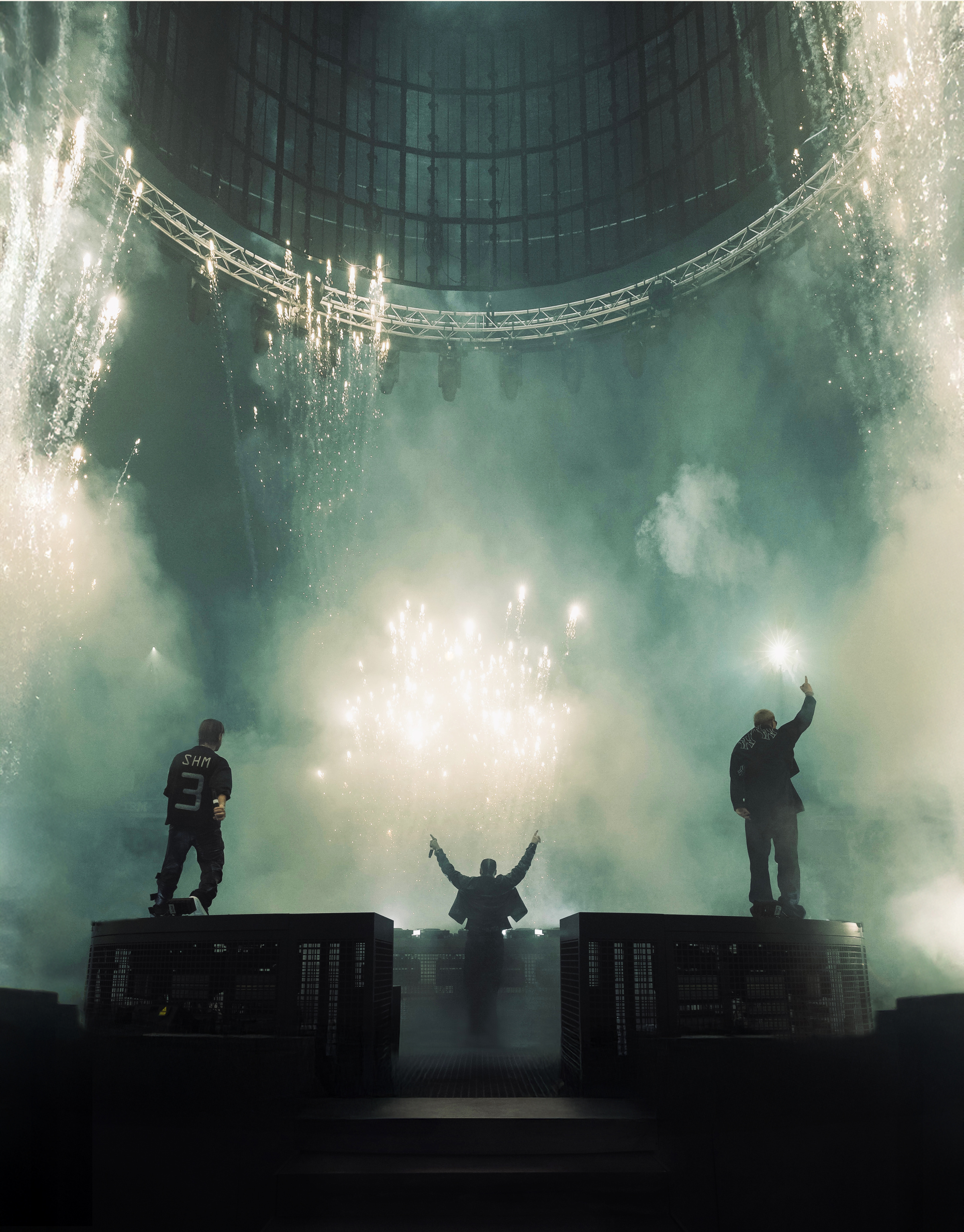When Ezequiel Pini first began using 3D rendering software, it was just after 6:05pm—the moment he closed out his day job and switched his mind to his own creative world. The number 6:05 became a kind of signature, an inside joke that now defines the name of his Barcelona-based studio, Six N. Five.
In the years since, he’s become one of the most recognized digital artists working today. You’ve almost certainly seen and liked one of his otherworldly interior renderings. Now for the first time, that language takes a physical form. In collaboration with Poltrona Frau—Italy’s century-old furniture house—Six N. Five has created a trio of objects that translate light into matter: a sculptural floor lamp, a celestial table lamp, and a silk rug. Each piece began as a digital sketch rooted in Ezequiel’s deep fascination with light, before being interpreted by Poltrona Frau’s craftspeople.
I sat down with Ezequiel during the launch of the new collection at Milan Design Week. Surrounded by the buzz of designers from around the world that had flooded into the Poltrona Frau showroom, he reflected on the process of making the work real, the evolving nature of digital craftsmanship, and how becoming a father changed his approach to time and space.
I read a story where you talked about 6:05pm and how that was your time to make personal work. I really connected with that. Has that concept stayed important in your process?
Yes absolutely. At the time 6:05pm was when I finished my day job. I worked in studios and agencies until 6pm, and 6:05pm was the start of “my” time when I could work on personal projects.
When I founded my own studio that flipped—now it’s 6:05am. I wake up early and start my day with that same personal intention. Those numbers still appear everywhere, even in technical details of my work. It’s almost like an inside joke with myself. That number is part of my identity.
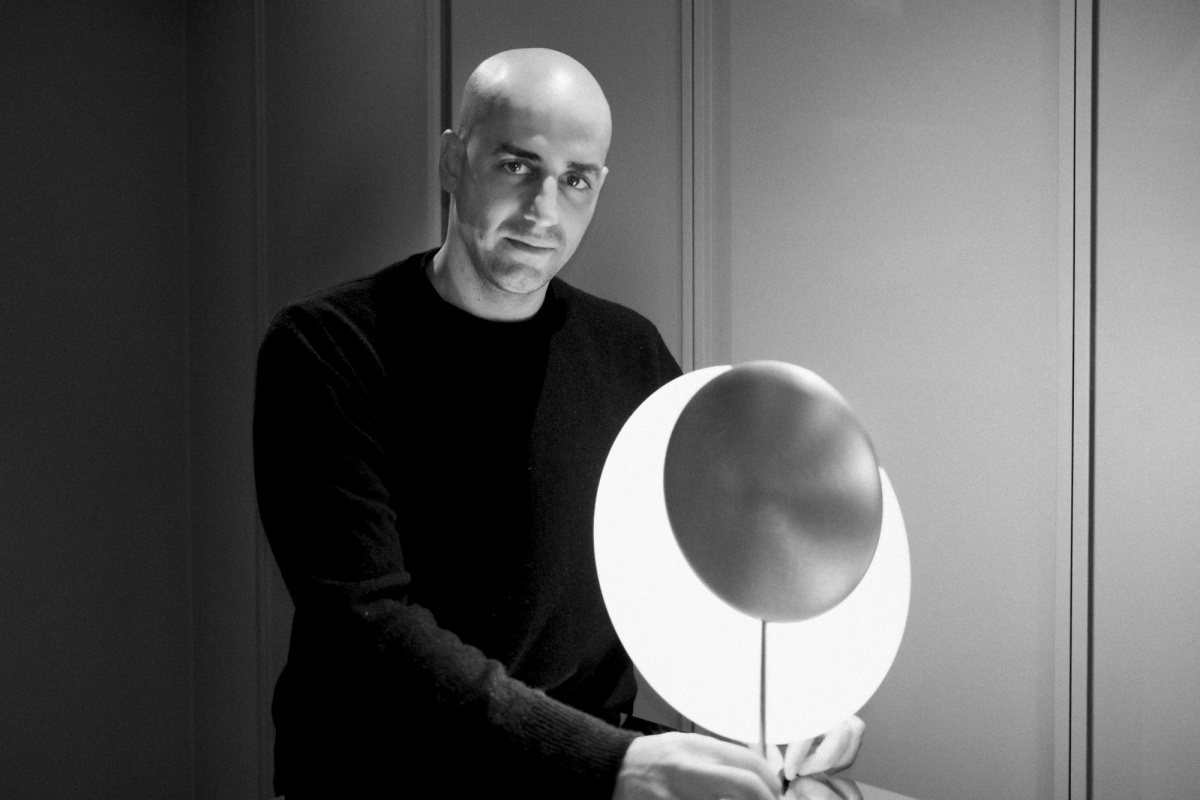
Ezequiel Pini with the Moonbeam lamp. Photo by Chris Force
I had no idea how many hours it takes to make a single image. Are you logging crazy hours in front of the computer?
Yes it’s a lot. I used to spend 10–12 hours a day. Now I try to find better balance because of family and other priorities but it’s still very time-consuming. The process is surprisingly traditional, like an artisan’s work. You build the model, place the materials, set the lights, and wait for renders.
In a world of AI and instant results, CGI might soon be remembered as the “traditional” way to create digital art. It’s slow and intentional.
On average I spend about eight hours at the studio. But when you run a small studio you also do management, emails, calls—all the behind-the-scenes stuff.
Sometimes I make up for that time later at home after the kids go to sleep. I love what I do, so it’s easy to get immersed and lose track of time.
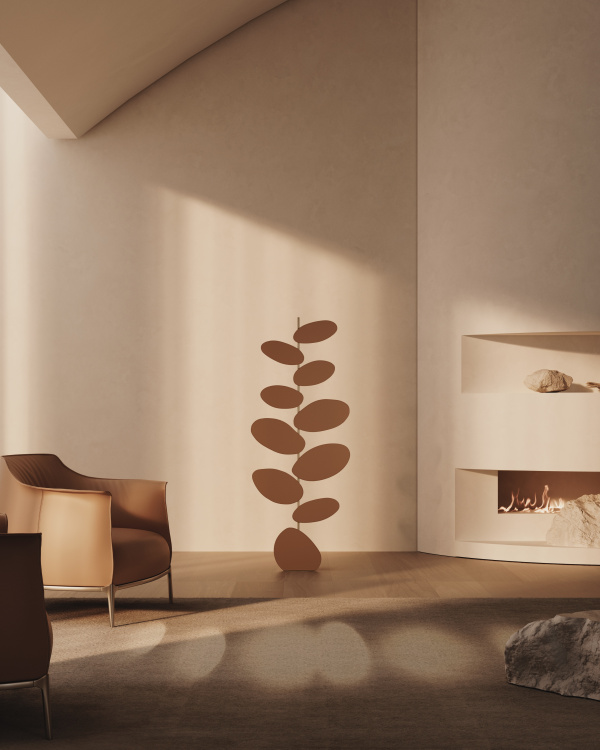
The Foliage lamp is a sculptural lighting piece that casts shadowy silhouettes of stylized leaves onto surrounding walls. Photo courtesy of Poltrona Frau
How has your practice changed since having kids? I imagine there are even more time constraints now.
I try not to work on weekends at all now—it’s like a rule for me. Before I’d often keep working on weekends. I love what I do so it didn’t feel like an effort. I just wanted to jump on the computer and keep creating.
But once you have kids and family other commitments come into play. You need to balance. So now, no work on weekends. I try to spend all morning with them. After the school drop-off I head to the studio and work through the afternoon.
Sometimes I stay a bit longer when everyone’s out just to enjoy a bit of quiet time—maybe I open a “door” I couldn’t before creatively. But then I go home to be there for the end of the day.
Eventually my plan is to restructure things so I don’t always need to be in the studio. I’d love for us to be able to work remotely together as a team. I haven’t done that yet because I have the studio space, but ideally I’d like to have some days remote, some days in the studio.
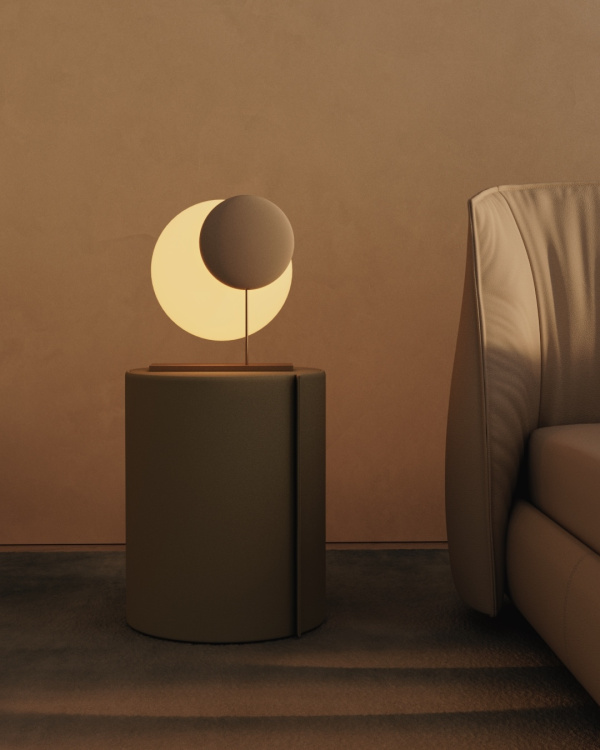
The Moonbeam lamp evokes a solar eclipse, with a luminous pearl-white glass disk partially eclipsed by a slender metal plate in brass or Pelle Frau leather. Photo courtesy of Poltrona Frau
How many people are in your studio now?
There are five of us. Actually the team already works remotely two days a week and I often go to the studio alone. At home I don’t really have a good workspace because my flat is small.
I’m moving soon to a house outside of Barcelona. It’s still close to the city but surrounded by nature. That’s really important to me.
Your work often features these beautiful, idyllic places and natural moments. But in reality you’re spending so much time in front of a screen. Does that ever make you crave nature even more?
I’ve been thinking about that. I grew up in a totally urban apartment in Buenos Aires. All my life was in the city. But when I moved in with my girlfriend I started getting into plants and building a little “green” space.
At the studio I even created a kind of jungle vibe. I’ve always loved nature, gardening, landscape design—maybe that passion was coming out unconsciously in my digital work. In the last year I’ve been seriously looking for a house with more access to nature and I finally found one. I’ve always been trying to escape the city in other ways too—biking a lot, doing marathons—just to be outside more.
Now I’m ready to have a permanent connection with nature in my daily life.
For this collaboration with Poltrona Frau, is this the first time your studio has made physical objects?
In this category yes. But I’ve done a few physical objects before more as explorations. Mostly chairs. They were all unique pieces or prototypes, kind of like collectible art editions.
For example I designed a 500-kilogram chair. I wanted to see what it would be like to take a 3D model and make it real. I sent the digital file to a marble company and they crafted this beautiful, super-heavy chair.
That’s how I like to work—everything is designed digitally including lighting and materials, and then I send off the final files with precise measurements. From there artisans bring it to life.
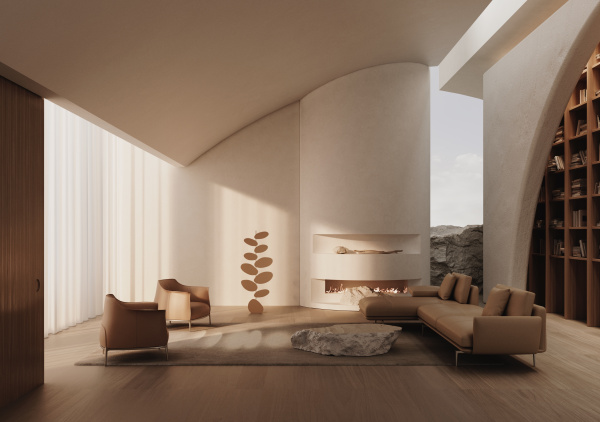
“Poltrona Frau’s current collection is called Five Seasons, and my recent inspiration has been very nature-focused, so it all just came together,” Ezequiel says. Photo courtesy of Poltrona Frau
Was the brief for this project specifically focused on lighting?
Yes it was. I started talking to Filippo Orelli, one of the company’s members, about three years ago. He saw my work while visiting a museum in Barcelona. We kept in touch and started talking about future collaborations.
A year ago he said it would be nice to do something together, and lighting felt like the natural choice. Lighting is a huge part of my work. I spend so much time placing light, choosing colors, simulating the sun, moon, even imaginary planets.
Their current collection is called Five Seasons, and my recent inspiration has been very nature-focused, so it all just came together.
Were your initial sketches close to what was ultimately produced, or did the design change a lot?
It depends on the piece. One of them stayed almost exactly the same, but the foliage piece went through more changes. Originally I wanted the petals to move with the light changing as they did—kind of an interactive projection. But it was too complex to engineer as a production-ready product.
If it had been a limited or unique edition we could have done it. But for a wider launch, we needed to simplify. We made a prototype of the moving version but realized it could cause issues. So we evolved the design while keeping the overall shape the same. We just adjusted the position and removed the movement to make it functional and reliable.
“People who follow traditional paths often follow set patterns. Since I never learned those patterns, I had to invent my own. That freedom has become one of my strengths.”
Can you imagine doing more of these design projects?
I’d love to keep exploring that. I’m also releasing some artistic sculpture work now—I have more freedom with it because I’m not limited by mass production concerns. When you’re doing something for mass production there are always budget limitations and other constraints. But with more artistic, collectible work you can be more experimental.
That said, I do think having a product is important too. It lets more people access what you’re doing. When it’s just a unique piece in a gallery it’s a different experience. So I want to work across both spaces.
What about physical spaces? Would you ever collaborate with architects on full environments?
Yes I’ve already started doing that. I designed a shop space in the Moco Museum in Barcelona. It’s a concept store and they’d collected some of my digital work. They said, “We love your sense of space, would you be interested in doing something physical?” I said, “Why not?”
I worked with a friend who’s an architect and he helped translate my renders into reality.
Right now my big project is actually the house I mentioned earlier. It’s a piece of architecture from 1985 with a grass-covered roof that is surrounded by nature. It’s a crazy house. I scanned the entire property with drones, created a detailed CGI model, and now I want to redesign it in my own way.
What do you have in mind for it?
I want to combine my sculptures and the natural environment and make the house feel like a complete experience. It used to belong to a lawyer and the original owner is still alive. He’s really excited to see it get a new life.
Right now I’m working on a first round of ideas. It’s all taking shape, but I’m also aware of the danger of never-ending iterations. When it’s your own space it’s so personal that you constantly want to change things.
Are you using AI in that process?
I’m very curious about AI. I use it during the early stages for concept development, references, moodboards, that kind of thing. It’s one part of the pool of tools I draw from. I think AI will play a bigger role as it develops further.
Right now it’s great for inspiration, but not detailed enough yet for the level of control I need in final work—especially in architectural or animation processes. I still do all the final production in CGI where I can control everything precisely. But how fast AI is evolving is incredible.
How have traditional architects and interior designers responded to your work? Especially with social media bringing more visibility.
It’s changed a lot. When I started using CGI about 15 years ago it was mostly seen as a visualization tool—just the last step in a traditional design process. You’d design everything first and then use CGI to render it realistically.
But for me CGI was always the first step. It’s where I start creating, not where I finish. Some people in the industry were skeptical. They saw me as a technician, like someone just operating a tool. When people label you that way they tend to dismiss the creative part.
But others saw it differently—they saw something new. That helped me a lot. When I arrived in Barcelona I connected with Ricardo Bofill’s studio. He was one of the main architects there and we collaborated on some big presentations—even concepts for creating new cities.
Their studio has its own 3D department but they brought me in to create surreal images and visions that felt like my own world. That validation helped me go further. Interestingly Ricardo once told me, “You have an advantage—you don’t have the contamination of formal architectural training.” That stuck with me. People who follow traditional paths often follow set patterns. Since I never learned those patterns, I had to invent my own. That freedom has become one of my strengths.
Did you learn any other major lessons from working so closely with Ricardo?
Not a lot in terms of quantity—I only had one or two opportunities to work directly with him—but those moments were incredibly meaningful. They were so close and personal. I really appreciated his vision and his respect for tradition.
He was in his 80s at the time and he’d call me directly. No emails just, “How’s it going? I love that. Why don’t we move this a little to the right?” It felt like talking to a grandfather with an artistic sensibility. And his feedback was always so precise. That kind of intuition is rare, and for me it was inspiring.
What really stayed with me was how he held onto his tools. It was like he was frozen in time. In a studio of 90 people he still worked with markers and paper. He had this big desk with all his markers arranged by size and color. That was his way. He’d sketch something out and then his team would convert it to digital.
I loved that—having your tools, whatever they are, and really sticking to them. That was a powerful lesson for me.
